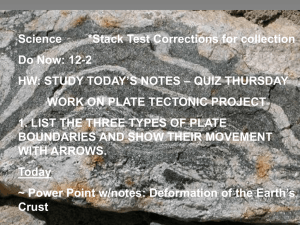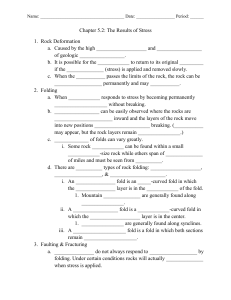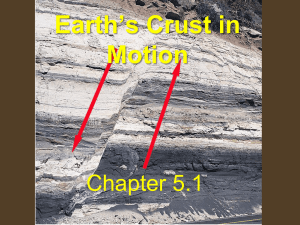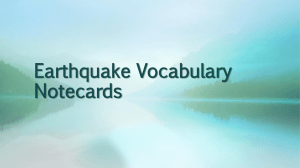Faults and Folds The earth`s crust is built up in layers. The oldest
advertisement
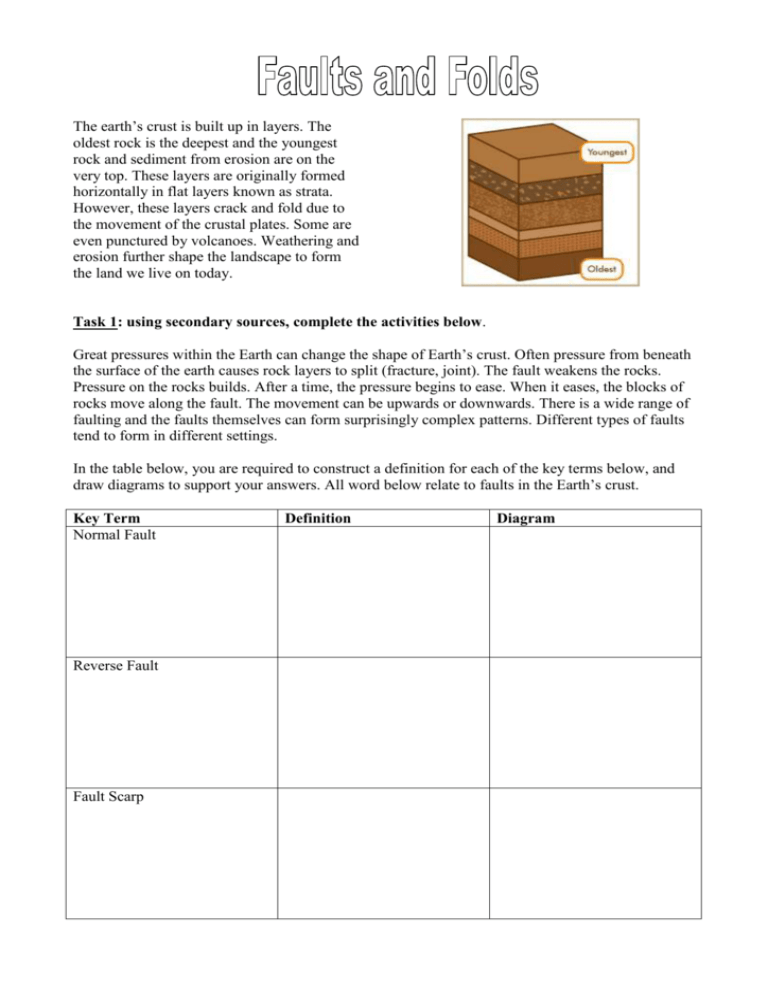
The earth’s crust is built up in layers. The oldest rock is the deepest and the youngest rock and sediment from erosion are on the very top. These layers are originally formed horizontally in flat layers known as strata. However, these layers crack and fold due to the movement of the crustal plates. Some are even punctured by volcanoes. Weathering and erosion further shape the landscape to form the land we live on today. Task 1: using secondary sources, complete the activities below. Great pressures within the Earth can change the shape of Earth’s crust. Often pressure from beneath the surface of the earth causes rock layers to split (fracture, joint). The fault weakens the rocks. Pressure on the rocks builds. After a time, the pressure begins to ease. When it eases, the blocks of rocks move along the fault. The movement can be upwards or downwards. There is a wide range of faulting and the faults themselves can form surprisingly complex patterns. Different types of faults tend to form in different settings. In the table below, you are required to construct a definition for each of the key terms below, and draw diagrams to support your answers. All word below relate to faults in the Earth’s crust. Key Term Normal Fault Reverse Fault Fault Scarp Definition Diagram Strike-slip Fault Horsts Graben 1. Fault scarps are often very rounded and not sharp like cliffs. Explain why this might be. ..................................................................................................................................................................................... ..................................................................................................................................................................................... ..................................................................................................................................................................................... ..................................................................................................................................................................................... 2. Horsts and graben exist along mid-ocean ridges, where new crust is being made. Explain why this might be. ..................................................................................................................................................................................... ..................................................................................................................................................................................... ..................................................................................................................................................................................... ..................................................................................................................................................................................... 3. Explain the difference between a reverse fault and a normal fault. ..................................................................................................................................................................................... ..................................................................................................................................................................................... ..................................................................................................................................................................................... ..................................................................................................................................................................................... Task 2: using secondary sources, complete the activities below. When continental plats collide, the rock of Earth’s crust is subject to extreme pressure, both vertically and horizontally. Under these conditions rock acts like modeling clay and begins to buckle and fold without breaking – scientists call this plastic behaviour. In the table below, you are required to construct a definition for each of the key terms below, and draw diagrams to support your answers. All word below relate to folds in the Earth’s crust. Key Term Anticline Syncline Monocline Overfold Unconformity Definition Diagram Symmetrical Fold Asymmetrical Fold 1. Describe the conditions that are required to make rock act in a plastic way. ..................................................................................................................................................................................... ..................................................................................................................................................................................... ..................................................................................................................................................................................... ..................................................................................................................................................................................... 2. Explain the difference between an anticline and a syncline. ..................................................................................................................................................................................... ..................................................................................................................................................................................... ..................................................................................................................................................................................... ..................................................................................................................................................................................... 3. Explain how folding could form mountains. Use a diagram to support your answer.. ..................................................................................................................................................................................... ..................................................................................................................................................................................... ..................................................................................................................................................................................... ..................................................................................................................................................................................... Task 3: match the geological feature with its appropriate definition. Fold The footwall of the fault moves either left or right laterally Anticline Compacted layers of sedimentary rock Syncline The bottom part or bottom arch of a folded rock Overfold The hanging wall of the fault moves up relative to the footwall. Monocline Linear strata dip in one direction between horizontal layers of strata. Strata This wall occurs above the fault line Fault This wall occurs below the fault line Normal Fault The hanging wall moves downwards relative to the footwall Reverse Fault Lateral (sideways) pressure pushes on the rock layers in part of the Earth’s crust. Upthurst block The top part of a folded rock Downthrust block Two normal faults push a block of rock upwards Strike-slip fault A build up of pressure in a fault eases quickly, causing rocks to move suddenly and the earth to shake Hanging wall A split or fracture in rock layers Footwall One limb of a fold lies partially under the other, and the resulting plane is inclined. Earthquake Two normal faults push a block of rock downwards Task 4: label each of the following diagrams. What geological feature are they depicting? In the cases of faults and fold, where is the pressure directed? Reverse fault, Anticline, Fault line, Monocline, Syncline, Overfold, Strike-slip fault, Normal fault, , Strata, Horsts and Graben Task 5: using your knowledge of plate tectonics and changes in earth’s crust, answer the questions below. 1. Explain why the Himalayas are still growing in height. ..................................................................................................................................................................................... ..................................................................................................................................................................................... ..................................................................................................................................................................................... ..................................................................................................................................................................................... 2. There is a lot of faulting as well as folding in the Himalayas. Explain how it would be possible for folding mountains to develop faults later in their geological history. ..................................................................................................................................................................................... ..................................................................................................................................................................................... ..................................................................................................................................................................................... ..................................................................................................................................................................................... 3. The San Andreas Fault makes much of coastal California including the cities of Los Angeles and San Francisco. a. Explain why the San Andreas Fault is called a slip fault. ..................................................................................................................................................................................... ..................................................................................................................................................................................... ..................................................................................................................................................................................... ..................................................................................................................................................................................... b. What causes major earthquakes along this fault? ..................................................................................................................................................................................... ..................................................................................................................................................................................... ..................................................................................................................................................................................... .....................................................................................................................................................................................

